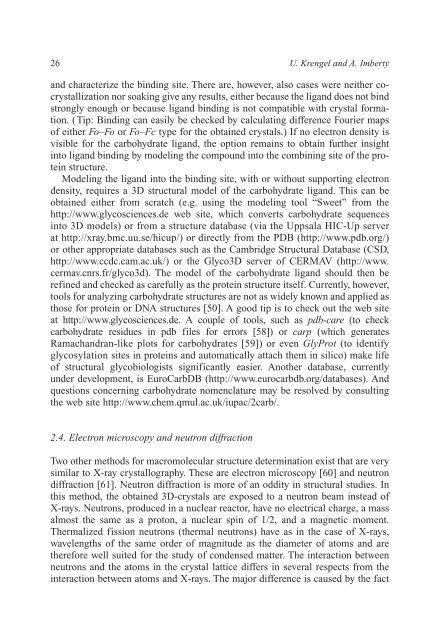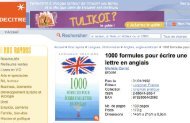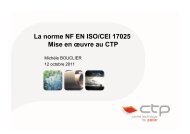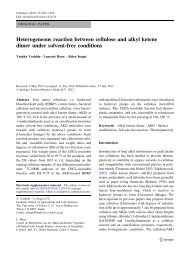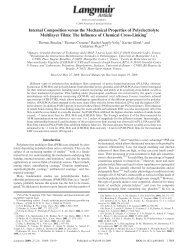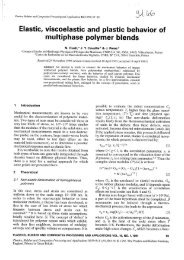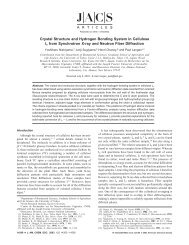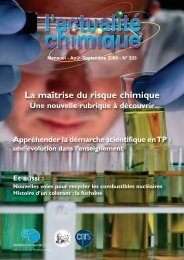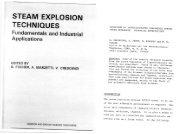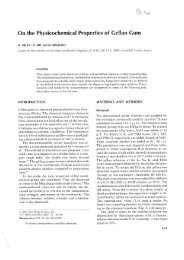Crystallography and Lectin Structure Database - CNRS
Crystallography and Lectin Structure Database - CNRS
Crystallography and Lectin Structure Database - CNRS
You also want an ePaper? Increase the reach of your titles
YUMPU automatically turns print PDFs into web optimized ePapers that Google loves.
26 U. Krengel <strong>and</strong> A. Imberty<br />
<strong>and</strong> characterize the binding site. There are, however, also cases were neither cocrystallization<br />
nor soaking give any results, either because the lig<strong>and</strong> does not bind<br />
strongly enough or because lig<strong>and</strong> binding is not compatible with crystal formation.<br />
(Tip: Binding can easily be checked by calculating difference Fourier maps<br />
of either Fo–Fo or Fo–Fc type for the obtained crystals.) If no electron density is<br />
visible for the carbohydrate lig<strong>and</strong>, the option remains to obtain further insight<br />
into lig<strong>and</strong> binding by modeling the compound into the combining site of the protein<br />
structure.<br />
Modeling the lig<strong>and</strong> into the binding site, with or without supporting electron<br />
density, requires a 3D structural model of the carbohydrate lig<strong>and</strong>. This can be<br />
obtained either from scratch (e.g. using the modeling tool “Sweet” from the<br />
http://www.glycosciences.de web site, which converts carbohydrate sequences<br />
into 3D models) or from a structure database (via the Uppsala HIC-Up server<br />
at http://xray.bmc.uu.se/hicup/) or directly from the PDB (http://www.pdb.org/)<br />
or other appropriate databases such as the Cambridge Structural <strong>Database</strong> (CSD,<br />
http://www.ccdc.cam.ac.uk/) or the Glyco3D server of CERMAV (http://www.<br />
cermav.cnrs.fr/glyco3d). The model of the carbohydrate lig<strong>and</strong> should then be<br />
refined <strong>and</strong> checked as carefully as the protein structure itself. Currently, however,<br />
tools for analyzing carbohydrate structures are not as widely known <strong>and</strong> applied as<br />
those for protein or DNA structures [50]. A good tip is to check out the web site<br />
at http://www.glycosciences.de. A couple of tools, such as pdb-care (to check<br />
carbohydrate residues in pdb files for errors [58]) or carp (which generates<br />
Ramach<strong>and</strong>ran-like plots for carbohydrates [59]) or even GlyProt (to identify<br />
glycosylation sites in proteins <strong>and</strong> automatically attach them in silico) make life<br />
of structural glycobiologists significantly easier. Another database, currently<br />
under development, is EuroCarbDB (http://www.eurocarbdb.org/databases). And<br />
questions concerning carbohydrate nomenclature may be resolved by consulting<br />
the web site http://www.chem.qmul.ac.uk/iupac/2carb/.<br />
2.4. Electron microscopy <strong>and</strong> neutron diffraction<br />
Two other methods for macromolecular structure determination exist that are very<br />
similar to X-ray crystallography. These are electron microscopy [60] <strong>and</strong> neutron<br />
diffraction [61]. Neutron diffraction is more of an oddity in structural studies. In<br />
this method, the obtained 3D-crystals are exposed to a neutron beam instead of<br />
X-rays. Neutrons, produced in a nuclear reactor, have no electrical charge, a mass<br />
almost the same as a proton, a nuclear spin of 1/2, <strong>and</strong> a magnetic moment.<br />
Thermalized fission neutrons (thermal neutrons) have as in the case of X-rays,<br />
wavelengths of the same order of magnitude as the diameter of atoms <strong>and</strong> are<br />
therefore well suited for the study of condensed matter. The interaction between<br />
neutrons <strong>and</strong> the atoms in the crystal lattice differs in several respects from the<br />
interaction between atoms <strong>and</strong> X-rays. The major difference is caused by the fact


